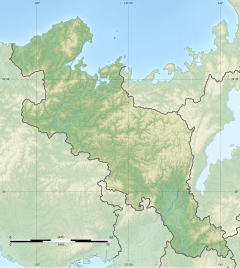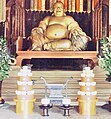Manpuku-ji
You can help expand this article with text translated from the corresponding article in Japanese. Click [show] for important translation instructions.
|
| Manpuku-ji | |
|---|---|
萬福寺 | |
 Manpuku-ji's Main Hall | |
| Religion | |
| Affiliation | Zen Buddhism |
| Sect | Ōbaku |
| Deity | Shaka Nyorai |
| Status | Head Temple |
| Location | |
| Location | Uji, Kyoto Prefecture |
| Country | Japan |
| Geographic coordinates | 34°54′51.32″N 135°48′21.83″E / 34.9142556°N 135.8060639°E |
| Architecture | |
| Founder | |
| Completed | 1661 |
| Website | |
| www | |
Manpuku-ji (Japanese: 萬福寺) is a Buddhist temple located in Uji, Kyoto Prefecture, approximately a 5-minute walk from Ōbaku Station.[1] It is the head temple of the Japanese Ōbaku Zen school, and named after Wanfu Temple in Fujian, China. The mountain is likewise named after Mount Huangbo, where the Chinese temple is situated.[2]
History
[edit]The temple was founded in 1661 by the Chinese monk Yinyuan Longqi (Ingen), officially opening in 1663.[3]
In 1664, control of the temple passed to Muyan, after which many Chinese monks followed as head priests.[4] Only the fourteenth priest and his successors are Japanese.[5]
On May 21, 1673 (Enpō 1, 5th day of the 4th month) Yinyuan (Ingen) died at the temple.[6]
The art of Senchadō is closely tied to the temple due to its founder.[7]
Architecture
[edit]The temple structures were constructed in Ming China's architectural style.[8]
The arrangement of buildings also follows Ming Dynasty architectural style, representing an image of a dragon.

The temple features an exemplary gyoban (fish board, used to toll the hours).[9]
Art
[edit]The temple's main statue is a seated Gautama Buddha. Sculptures by the Chinese sculptor known as Han Do-sei[10] and latticed balustrades can also be seen.
Above the gate of the temple is a carving of the Chinese Characters "義一第", (read right-to-left, "The First Principle") carved from the writing of Imakita Kosen and said to have been the artist's eighty-fifth attempt before he finally wrote with a mind free from the distraction of a pupil's criticism.[11]
The temple treasure house contains a complete collection of Buddhist scriptures commissioned by Tetsugen Doko and completed in 1678, comprising approximately 60,000 printing blocks which are still in use.[12][13] The production of the printing blocks was funded by donations collected throughout the country for many years and through many troubles.[13]
Gallery
[edit]-
Balustrades, in manji-kuzushi (卍崩し, simplified swastika) style
-
Gate
-
Altar to Kansei Teikun
-
Statue of Hotei
See also
[edit]Notes
[edit]- ^ Bornoff, Nicholas (2008). Japan. National Geographic. p. 233.
- ^ Wu, Jiang (2015). Leaving for the Rising Sun: Chinese Zen Master Yinyuan and the Authenticity Crisis in Early Modern East Asia. Oxford University Press. p. 2. ISBN 9780199393121.
- ^ Winfield, Pamela D.; Heine, Steven, eds. (7 June 2017). Zen and Material Culture. Oxford University Press. pp. 139–140. ISBN 9780190469313.
- ^ Buswell Jr., Robert E.; Lopez Jr., Donald S. (24 November 2013). The Princeton Dictionary of Buddhism. Princeton University Press. p. 529. ISBN 9781400848058.
- ^ Hershock, Peter D. (14 March 2014). Public Zen, Personal Zen: A Buddhist Introduction. Rowman & Littlefield. p. 134. ISBN 9781442216143.
- ^ Titsingh, Isaac. (1834). Annales des empereurs du japon, p. 414.
- ^ "Volume 5". Intersect. University of Michigan: PHP Institute. 1989. p. 25. Retrieved 2 January 2024.
- ^ Yanagida, Seizan (2009). "Historical Introduction to The Record of Linji". The Record of Linji. Honolulu: University of Hawaii Press. p. 115. ISBN 9780824833190.
- ^ 秋山光和 (1967). 原色日本の美術: 禅寺と石庭. University of California: 小学館. p. 236.
- ^ "A Representative Magazine of Things Japanese". The Japan Magazine. Vol. 7. New York Public Library: Japan Magazine Company. 1916. Retrieved 4 January 2024.
- ^ Reps, Paul; Nyogen Senzaki (1998). Zen Flesh, Zen Bones: A Collection of Zen and Pre-Zen Writings. ISBN 0-8048-3186-6.
- ^ Konishi, Yoshiaki (3 January 2023). "Kyoto Zen temple seeks to preserve history a ramen bowl at a time". The Asahi Shimbun. Uji, Kyoto Prefecture. Retrieved 3 January 2024.
- ^ a b Gustav, Konang (1972). A Millennium of Printing in China, Korea and Japan. Royal Library. p. 10. ISBN 9789170000119.
References
[edit]- Titsingh, Isaac. (1834). Annales des empereurs du Japon. Paris: Oriental Translation Fund of Great Britain and Ireland. OCLC 251800045; see also Imprimerie Royale de France, OCLC 311322353
External links
[edit]![]() Media related to Manpuku-ji at Wikimedia Commons
Media related to Manpuku-ji at Wikimedia Commons
- Manpuku-ji – official page (map) (in Japanese)






